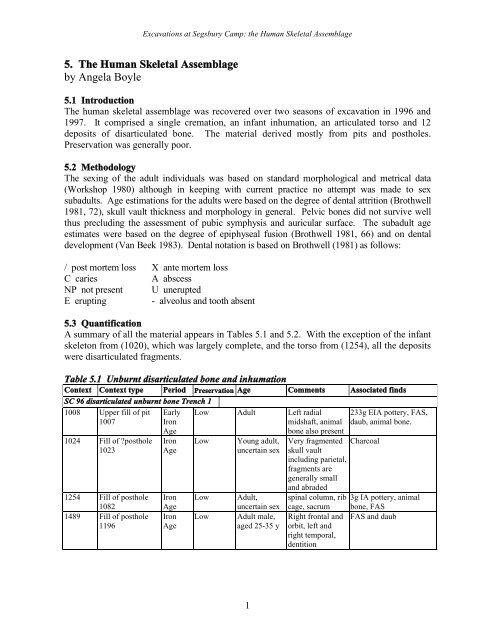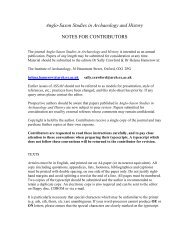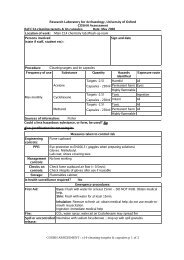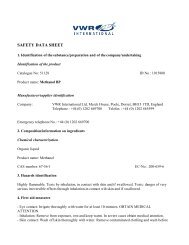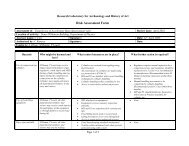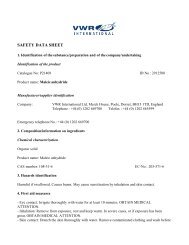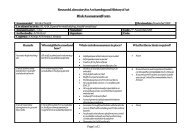5. The Human Skeletal Assemblage by Angela Boyle
5. The Human Skeletal Assemblage by Angela Boyle
5. The Human Skeletal Assemblage by Angela Boyle
You also want an ePaper? Increase the reach of your titles
YUMPU automatically turns print PDFs into web optimized ePapers that Google loves.
Excavations at Segsbury Camp: the <strong>Human</strong> <strong>Skeletal</strong> <strong>Assemblage</strong><br />
<strong>5.</strong> <strong>The</strong> <strong>Human</strong> <strong>Skeletal</strong> <strong>Assemblage</strong><br />
<strong>by</strong> <strong>Angela</strong> <strong>Boyle</strong><br />
<strong>5.</strong>1 Introduction<br />
<strong>The</strong> human skeletal assemblage was recovered over two seasons of excavation in 1996 and<br />
1997. It comprised a single cremation, an infant inhumation, an articulated torso and 12<br />
deposits of disarticulated bone. <strong>The</strong> material derived mostly from pits and postholes.<br />
Preservation was generally poor.<br />
<strong>5.</strong>2 Methodology<br />
<strong>The</strong> sexing of the adult individuals was based on standard morphological and metrical data<br />
(Workshop 1980) although in keeping with current practice no attempt was made to sex<br />
subadults. Age estimations for the adults were based on the degree of dental attrition (Brothwell<br />
1981, 72), skull vault thickness and morphology in general. Pelvic bones did not survive well<br />
thus precluding the assessment of pubic symphysis and auricular surface. <strong>The</strong> subadult age<br />
estimates were based on the degree of epiphyseal fusion (Brothwell 1981, 66) and on dental<br />
development (Van Beek 1983). Dental notation is based on Brothwell (1981) as follows:<br />
/ post mortem loss X ante mortem loss<br />
C caries<br />
A abscess<br />
NP not present U unerupted<br />
E erupting - alveolus and tooth absent<br />
<strong>5.</strong>3 Quantification<br />
A summary of all the material appears in Tables <strong>5.</strong>1 and <strong>5.</strong>2. With the exception of the infant<br />
skeleton from (1020), which was largely complete, and the torso from (1254), all the deposits<br />
were disarticulated fragments.<br />
Table <strong>5.</strong>1 Unburnt disarticulated bone and inhumation<br />
Context Context type Period Preservation Age Comments Associated finds<br />
SC 96 disarticulated unburnt bone Trench 1<br />
1008 Upper fill of pit<br />
1007<br />
Early<br />
Iron<br />
Low Adult Left radial<br />
midshaft, animal<br />
1024 Fill of posthole<br />
1023<br />
1254 Fill of posthole<br />
1082<br />
1489 Fill of posthole<br />
1196<br />
Age<br />
Iron<br />
Age<br />
Iron<br />
Age<br />
Iron<br />
Age<br />
Low<br />
Low<br />
Low<br />
Young adult,<br />
uncertain sex<br />
Adult,<br />
uncertain sex<br />
Adult male,<br />
aged 25-35 y<br />
bone also present<br />
Very fragmented<br />
skull vault<br />
including parietal,<br />
fragments are<br />
generally small<br />
and abraded<br />
233g EIA pottery, FAS,<br />
daub, animal bone.<br />
Charcoal<br />
spinal column, rib 3g IA pottery, animal<br />
cage, sacrum bone, FAS<br />
Right frontal and FAS and daub<br />
orbit, left and<br />
right temporal,<br />
dentition<br />
1
Excavations at Segsbury Camp: the <strong>Human</strong> <strong>Skeletal</strong> <strong>Assemblage</strong><br />
Context Context type Period Preservation Age Comments Associated finds<br />
SC 97 complete skeleton<br />
1020 Upper fill of pit<br />
1019<br />
Iron<br />
Age<br />
SC 97 disarticulated unburnt bone<br />
1733 Secondary fill of<br />
large pit 1336<br />
Iron<br />
Age<br />
Low 2 years +/- 8<br />
months<br />
Medium<br />
Adult,<br />
female<br />
6000 Unstratified Low Adult,<br />
uncertain sex<br />
6003 Fill of main ditch Iron Low Adult,<br />
cut 6002 Age<br />
uncertain sex<br />
7023 Fill of possible<br />
posthole 7022<br />
Iron<br />
Age<br />
7302 Spoil from Iron<br />
modern road cut Age<br />
7365 Chalk rubble layer Iron<br />
within main Age<br />
hillfort rampart<br />
7619 Fill of main Iron<br />
enclosing ditch Age<br />
7607 outside<br />
rampart<br />
7621 Primary rubble fill Iron<br />
of ditch 7607 Age<br />
Low<br />
Low<br />
Medium<br />
Medium<br />
Medium<br />
Adult,<br />
uncertain sex<br />
Adult,<br />
uncertain sex<br />
Adult,<br />
uncertain sex<br />
Adult,<br />
uncertain sex<br />
Adult,<br />
uncertain sex<br />
Virtually<br />
complete, pottery<br />
and charcoal<br />
present<br />
344g EIA pottery, animal<br />
bone, daub<br />
Right humerus, 7g IA pottery, animal<br />
missing proximal bone<br />
end and one third<br />
of distal end, very<br />
gracile<br />
Skull vault 7g IA pottery, animal<br />
fragments<br />
right distal<br />
humerus (very<br />
abraded)<br />
Right femur head Animal bone<br />
Radial midshaft<br />
Midshaft of<br />
humerus<br />
Left femur<br />
midshaft<br />
bone<br />
21g IA and RB pottery,<br />
animal bone, FAS, 1 flint,<br />
20 slingstones<br />
32g IA pottery, flint, daub,<br />
animal bone<br />
4g EIA pottery<br />
99g IA pottery, RB<br />
pottery, animal bone, 5<br />
slingstones<br />
Right humerus, Animal bone<br />
missing proximal<br />
and distal ends,<br />
ends are very<br />
ragged though<br />
bony surface is<br />
very smooth and<br />
whitened, muscle<br />
insertions not well<br />
marked<br />
Table <strong>5.</strong>2 <strong>The</strong> cremation<br />
Context Context type Period Weight Identifiable fragments Colour Age and<br />
2042 Fill of irregular<br />
pit 2041<br />
Iron<br />
Age<br />
547 g skull vault, 3rd molar<br />
root, premolar root, rib,<br />
humerus, fibula<br />
Uniformly<br />
white and<br />
well<br />
calcined<br />
sex<br />
Adult<br />
female<br />
Dentition survived in two examples and is summarised in Table <strong>5.</strong>3 and <strong>5.</strong>4.<br />
Table <strong>5.</strong>3 <strong>The</strong> dentition of 1489<br />
- - - - - - - - 1 2 3 4 5 6 7 8<br />
- - - - - - - - - - - - - - - -<br />
Comments<br />
Charcoal, burnt<br />
flint present<br />
2
Excavations at Segsbury Camp: the <strong>Human</strong> <strong>Skeletal</strong> <strong>Assemblage</strong><br />
Table <strong>5.</strong>4 <strong>The</strong> dentition of infant 1020<br />
U U<br />
6 e d c b a a b c d e 6<br />
6 e d c b a - - - - - -<br />
U<br />
<strong>5.</strong>4 Provenance<br />
Trench 1<br />
Four deposits of human bone were recovered from Trench 1 in 1996. <strong>The</strong>se were from pits or<br />
postholes located around the outside the southern circular gully (roundhouse) [1003]. Two of<br />
the deposits came from features to the south-east, [1023] and [1082], another from north of it<br />
(feature [1007]) and the fourth was found to the north-west, [1196].<br />
During the 1997 season a further two deposits of human bone were recovered from pits<br />
[1019] and [1336] which were located to the south of the northernmost roundhouse gully.<br />
Trench 2<br />
A deposit of cremated human bone was present in a shallow pit [2041] located in the centre of<br />
Trench 2.<br />
Trench 6<br />
Skull vault fragments were found in the topsoil (6000). An adult right distal humerus was<br />
found in the uppermost fill of main ditch cut [6002], which is a possible hornwork ditch at the<br />
eastern entrance of the hillfort leading off from the main enclosing ditch.<br />
Trench 7<br />
Five deposits of human bone were excavated in this trench. One from the fill of a posthole<br />
[7022], two from fills (7619) and (7621) of the main enclosing ditch [7607] and one from<br />
layer (7302), probably the spoil from a modern road cut. A single fragment derived from a<br />
chalk rubble layer (7365) within the main hillfort rampart.<br />
<strong>5.</strong>5 Discussion<br />
Apart from the cremation, these deposits fall within a well-known Iron Age tradition of<br />
human bone (articulated and disarticulated) in and around settlement sites. Examples local to<br />
Segsbury include Yarnton Worton Rectory Farm (Hey et al. 1999, 58) where a number of<br />
neonates and eight deposits of disarticulated bone were recovered from settlement features.<br />
At Gravelly Guy, Stanton Harcourt 65 deposits of bone were recovered from pits, ditches,<br />
shallow scoops and postholes (Lambrick and Allen 2005). No less than 48 of the deposits<br />
were infants.<br />
<strong>The</strong>re is some suggestion (Wait 1995, 94) that while the late Bronze Age and early Iron Age<br />
was characterised <strong>by</strong> the presence of single bones on both hillforts and settlements (Brück<br />
1995), the middle Iron Age saw a dramatic increase in the number of formal inhumation<br />
burials on settlements, albeit in storage pits, with a corresponding decrease in the number of<br />
deposits of single bones.<br />
3
Excavations at Segsbury Camp: the <strong>Human</strong> <strong>Skeletal</strong> <strong>Assemblage</strong><br />
It has been argued (Fitzpatrick 1997, 82) that since human remains in pits constitute the<br />
majority of archaeologically recoverable evidence at this time, a priori they represent the<br />
typical. However, there is mounting evidence, mainly the identification of Iron Age<br />
inhumation cemeteries <strong>by</strong> radiocarbon dating, that human pit burials do not represent the<br />
normal Iron Age burial rite, but have some other significance, possibly representing sacrificial<br />
offerings.<br />
Excarnation<br />
Excarnation <strong>by</strong> exposure is assumed to be the most likely mortuary practice at least in the<br />
early and middle Iron Age. It has been argued that four-post structures which are a common<br />
feature of Iron Age settlements may have served as excarnation platforms (Ellison and<br />
Drewett 1971, Walker 1984, 457).<br />
Isolated, articulated limbs must derive from a recently deceased individual, not so fresh that<br />
the limb would have been strongly held to the body, but not so old that the corpse would have<br />
been skeletonised, perhaps the only tissue surviving would have been the ligaments, which<br />
are among the last tissues to decay. An alternative is dismemberment of the body and<br />
removal of body parts before decay. Cut marks from this procedure should be visible on the<br />
bones in the area of the muscle attachments, depending on the skill of the person(s) involved<br />
(Carr and Knüsel 1997, 167).<br />
Clearly the deposit (1254) was at least partially articulated when it was buried but only the<br />
torso remained. This is in contrast to the humerus in (7621) for example, which has a<br />
smoothed and whitened appearance as though it had been left exposed for some considerable<br />
time.<br />
<strong>The</strong> cremation<br />
An average adult cremation can weigh between 1000-2400g if complete (McKinley 1997, 68;<br />
observations at modern crematoria). At 547g it is clear that the deposit in (2042) does not<br />
represent the entire remains of any one individual.<br />
<strong>5.</strong>6 Conclusion<br />
Pits which contain human remains are often close to the settlement limits (Wait 1995), while<br />
the boundaries of settlements are increasingly recognised as being as much of social and<br />
symbolic significance as practical (Hingley 1984). Thus the appearance of deposits of human<br />
bone in such contexts should not necessarily be seen as surprising. Even so, at Segsbury<br />
many of the deposits occur in Trench 1 in the interior of the hillfort associated with the<br />
roundhouse structures. <strong>The</strong> remaining human deposits were associated with the enclosing<br />
rampart and ditches. <strong>The</strong> enclosure boundary, which demarcated and helped define the<br />
settlement and its occupants, may have been equated with rites of passage, which also<br />
involved crossing barriers (Hill 1995). This could be why the structured ritual deposits<br />
associated with rites of passage (from life to death) are seen in such locations. <strong>The</strong> function<br />
of a rite of passage is to reduce the harmful effects of transitions over boundaries, thus it<br />
would be logical to expect human remains to be placed in such locations.<br />
4
Excavations at Segsbury Camp: the <strong>Human</strong> <strong>Skeletal</strong> <strong>Assemblage</strong><br />
Bibliography<br />
BROTHWELL, D. 1981: Digging up bones (London, British Museum)<br />
BRUCK, J. 1995: A place for the dead; the role of human remains in late Bronze Age Britain<br />
Proceedings of the Prehistoric Society 61, 247-277<br />
CARR, G. and KNUSEL, C. 1997: ‘<strong>The</strong> ritual framework of excarnation <strong>by</strong> exposure as the<br />
mortuary practice of the early and middle Iron Ages of central southern Britain’ in Gwilt, A. and<br />
Haselgrove, C. (eds), Reconstructing Iron Age Societies. New Approaches to the British Iron Age<br />
(Oxford, Oxbow Monograph 71) 167-173<br />
ELLISON, A. and DREWETT, P.L. 1971: Pits and postholes in the British early Iron Age: some<br />
alternative explanations. Proceedings of the Prehistoric Society 37, 183-194<br />
FITZPATRICK, A.P. 1997: Everyday life in Iron Age Wessex, in Gwilt, A. and Haselgrove, C.<br />
(eds), Reconstructing Iron Age Societies. New Approaches to the British Iron Age (Oxford,<br />
Oxbow Monograph 71) 73-86<br />
GWILT, A. and HASELGROVE, C. 1997: Reconstructing Iron Age societies. New approaches<br />
to the British Iron Age (Oxford, Oxbow Monograph 71)<br />
HEY, G., BAYLISS, A. and BOYLE, A. 1999: Iron Age inhumation burials at Yarnton,<br />
Oxfordshire. Antiquity 73, 551-562<br />
HILL, J.D. 1995: Ritual and rubbish in the Iron Age of Wessex (Oxford, BAR Brit. Ser. 242)<br />
HINGLEY, R. 1984: <strong>The</strong> archaeology of settlement and the social significance of space. Scottish<br />
Archaeological Review 3, 22-27<br />
LAMBRICK, G. and ALLEN, T.G. 2005: Gravelly Guy, Stanton Harcourt: the development of a<br />
prehistoric and Romano-British community (Oxford, Thames Valley Landscapes Monograph 21)<br />
McKINLEY, J. 1997: <strong>The</strong> cremated human bone from burial and cremation-related contexts. in<br />
Fitzpatrick, A.P. (ed.), Archaeological excavations on the route of the A27 Westhampnett Bypass,<br />
West Sussex, 1992. Volume 2: the cemeteries (Wessex Archaeology Report No 12) 55-73<br />
VAN BEEK, G.C. 1983: Dental morphology. An illustrated guide, 2nd edition (Bristol)<br />
WAIT, G.A. 1995: Ritual and religion in Iron Age Britain (Oxford, BAR British Series 90)<br />
WALKER, L. 1984: ‘Population and behaviour’ in Cunliffe, B.W., Danebury: an Iron Age<br />
hillfort in Hampshire. Vols 1-2. <strong>The</strong> excavations 1969-1978 (London, CBA Research. Report 52),<br />
442-474<br />
Workshop of European Anthropologists 1980: Recommendations for age and sex diagnoses of<br />
skeletons Journal of <strong>Human</strong> Evolution 9, 517-549<br />
5


